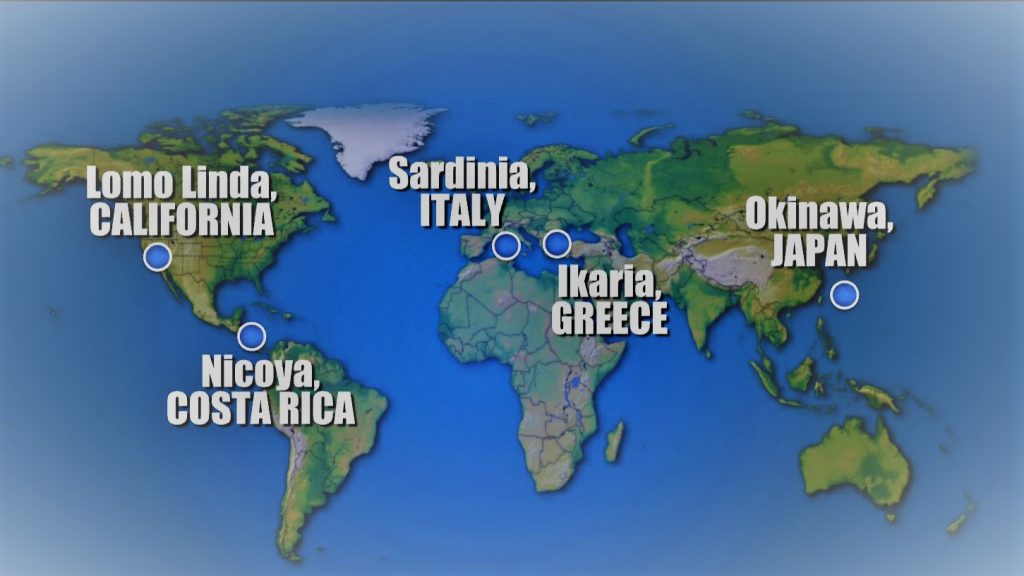By His Grace and Blessings, I write
Ageing, longevity and immortality: Lessons from the Blue Zones
The term Blue Zone first coined by Italian Epidemiologist Gianni Pes and Belgian Demographer Michel Poulin who were investigating rates of mortality in the island of Sardinia. In 2004, Dan Buettner teamed up with National Geographic to locate more of such zones. The blue zones and the unique features of these zones which are sometimes referred to as the “Islands where people forgot to die” or even the “islands of immortals” will be subject matter of this blog.
What is a Blue Zone?
To qualify as a Blue Zone, people living there have to be largely free of afflictions like heart diseases, obesity, cancer and diabetics, and at the same time they have to have a very high percentage of centenarians in their population. So, zones with highest life expectancies and health-spans are called Blue Zones. The 5 zones identified by team of researchers are..
- Okinawa (Japan)
- Ikaria (Greece)
- Sardinia (Italy)
- Nicoya Peninsula (Costa Rica)
- Loma Linda (California)
While these zones differed in terms of geography, food habits and genetic composition, there were certain commonalities that led people in these places to live longer and healthier lives. The number of centenarians in these zones is very high in comparison other places. Take for example the Nuoro Province in the Sardinian highlands where there are 10 times more centenarians than America. Here in most of the cases, male and female both live past 100 with health-spans. Similarly, Okinawa islands in Japan, is known for the world’s oldest female population. It’s a place where people have longest disability free life expectancy in the world.
The Commonalities:
Physical Activity
In all these zones people set their lives so that they are constantly nudged into physical activity. In Okinawa for instance, women sit on the floor and get up and sit 30/40 times a day. Sardinians mostly live in vertical houses and for every activity they go up and down the stairs. Similarly, for the Seventh Adventists in California, nature walk with family is an integral part of the lifestyles. In all these cultures, working by hand is very much ingrained in the mindset of the people.
Downshift or slowdown:
Each of these cultures take time to downshift. Sardinians pray, the Okinawa’s venerate ancestors. The seventh Adventists have a 24-hour sanctuary time every week during which they go to church with their families, go for nature walks, focus on their social networks.
Social and Family Connections :
In all these cultures there are important connections with family, friends and society. They put their loved ones and families first, take care of their children and ageing parents and tend to unite as communities of common faiths. The social constructs and relationships in all these cultures helps in longer and healthier living. In-fact in many of these cultures’ friendships ( normally 4 to 6 in a group) enduring for 100 of years have been found amongst the members of the groups.
In a meta-analysis, Julianne Holt-Lunstad, a psychologist at Brigham University found that quality of our relationships is as important to our health as exercise or food. It is estimated that these connections along with various common religious practices, adds 3 to 5 years of life expectancy. The amazing results from the longest Harvard study of 750 individuals was fully discussed in my blog on Happiness, Relationships and Lockdown.
Food Habits:
People in these zones are mostly vegetarians, even though they live near the sea. Moreover, the way they eat instead of what they eat is important to them. All of them invariably prevent overeating by sticking to certain principles like calorie restriction or fasting etc. There are 10’s of thousands of research paper establishing that calorie restriction is the most effective intervention to delay ageing and living a healthy life.
Purpose of Life:
In all these cultures members have a sense of purpose. While Ikigai rules the world of Okinawa’s, every community in these zones lives with a sense of purpose revolving around serving their elders and community members. This sense of purpose is one the most important factor for longer healthier lives according to Harvard researchers.
Efforts have been made by researchers and policy makers and planners to incorporate the astounding features of these zones in public policy sphere. For example, Buettner and his team tried Reverse Engineering of Blue Zones in rural Minnesota. The environment in this area was altered to replicate that of blue zones. People were nudged to be more physically active through ecosystem changes. It led to decreased incidence of many chronic and lifestyle diseases like obesity, diabetics and cardiovascular problems. Life expectancies and health-spans have improved in these areas.
It’s time that we learn our lessons well. Our traditional cultures and lifestyles can teach us so much. If we could properly adopt and adept to the lifestyles of these Blue Zones we may have longer and healthier lifespans. The need of the hour is to change our mindset and find purpose of our lives.
By His Grace and Blessings, I write..
Dr. Seema Chaudhary


2 Responses
Really the people inhabiting Blue Zones share common lifestyle characteristics that contribute to their longevity. Everyone must follow their lifestyle for one’s own stake. Expecting more such amazing articles, Madam.
Thanks Baitha Ji…so nice to hear from you ..we can all learn from such positive things which give us hope and happiness..blue zones lifestyle are worth emulating and can help us in leading a healthier and longer life…thanks once again for your insightful observations..